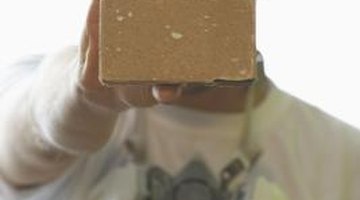How to Fix Runs in Single Stage Paint
Single stage auto paint features a natural UV protectant that hazes onto the surface, and disturbing this bonded finish can expose your car to more oxidation down the road. If you get runs in your single state paint job, however, you must sand them out. Work carefully and slowly, and do all the work by hand to minimize the damage. Sand and buff your car outside on a clear day with no chance of rain.

-
Let your single stage paint job dry for at least 24 hours before trying to remove the runs.
-
Fill a bowl with water. Wrap 1,000-grit wet sandpaper around a wooden block, and dip it in the bowl.
-
Fill a small spray bottle with water and spritz it onto the run in your single stage paint. Rub the wet sandpaper back and forth over the run to remove the paint. Spray the area often with the water to keep it wet, and repeatedly dip your sandpaper in the water to dislodge paint chips and keep it wet.
-
Continue working on one run until you can't see or feel the thicker paint in the run and the area looks smooth, then sand other runs with the 1,000-grit wet sandpaper.
-
Sand all the runs with 1,500-grit sandpaper just as you did with the 1,000-grit sandpaper in Steps 3 and 4 for a finer finish. Keep working until the areas are completely smooth.
-
Pour a dime-sized amount of rubbing compound onto a sponge. Work the rubbing compound over the sanded areas in concentric circles, covering the areas completely. Let the rubbing compound haze over, then wipe it off with a clean rag. Once you've wiped off the rubbing compound, your car will start to look glossy again.
-
Apply finishing compound just like you applied the rubbing compound in Step 6. Wipe off the finishing compound to restore the full shine to your run-free single stage auto paint.
References
Tips
- Wait at least 30 days to wax your ride after painting it.
- You can use a mechanical buffer with the rubbing compound, but if you're not careful you can buff through the auto finish down to bare metal. Working by hand gives you more control than using a buffer.
Writer Bio
A successful website writer since 1998, Elton Dunn has demonstrated experience with technology, information retrieval, usability and user experience, social media, cloud computing, and small business needs. Dunn holds a degree from UCSF and formerly worked as professional chef. Dunn has ghostwritten thousands of blog posts, newsletter articles, website copy, press releases and product descriptions. He specializes in developing informational articles on topics including food, nutrition, fitness, health and pets.
Photo Credits
- Jupiterimages/Photos.com/Getty Images
More Articles



